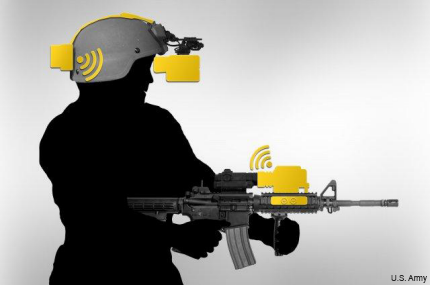With new night-vision goggles, soldiers don't need a scope to aim
The system wirelessly connects the goggles with a weapon-mounted sight, allowing soldiers to shoot from the hip or around corners without exposing themselves.

Army researchers have combined improved night-vision equipment and wireless technology to give soldiers the Wild West gunslinger-like ability of shooting from the hip accurately. Even more, it could also allow them to shoot around corners without exposing themselves.
The Enhanced Night Vision Goggle III, or ENVG III, is the latest version of a device the Army has been using for nearly a decade. Like earlier versions, ENVG III is worn on a helmet, but it is connected wirelessly to a system mounted on a weapon, called the Family of Weapon Sights - Individual, or FWS-I, which takes video from the weapon’s point of view and transmits it to the goggles, the Army said in a news release. The soldier sees what the weapon “sees,” allowing the soldier to aim without having to raise the scope to eye level.
Version III of the goggle has other advantages, too. It presents a higher-resolution image with greater range, for one thing, and its 40-degree view provides greater situational awareness that the 18-to-26 degrees soldiers get through a scope. A processor merges the FWS-I and ENVG III images, allowing soldiers to simultaneously see night-vision and thermal images. The latter is significant because it allows soldiers tom pick up heat signatures in degraded environments, such as smoke, the Army said.
It also is smaller and lighter than earlier ENVG versions, using only four batteries in a “smart battery pack” at the back of the helmet instead of the previous eight, the Army said. But it also can work with the eight-battery pack used for ENVG 1 and II, which will still be ion use as version III is fielded.
The goggles were developed by the Maneuver Center of Excellence at Fort Benning, Ga., and the Army Training and Doctrine Command at Fort Eustis, Va., along with other Army researchers and contractors BAE Systems and DRS Technologies. Soldier feedback was a constant part of the process, and will continue to be as the Army further refines the system.
The FWS-I works with a variety of weapons, including the M4 carbine, M16A4 rifle, M249 Squad Automatic Weapon, M136 AT4 rifle, or M141 Bunker Defeat Munition. Variants of FWS are being developed for sniper rifles, the M240 and M2 machine guns, and the MK19 grenade launcher.
The Army plans to start fielding ENVG III in 2017 and FWS-I in 2019, with 18 soldiers per platoon equipped with the FWS-I and 24 with ENVG III.




